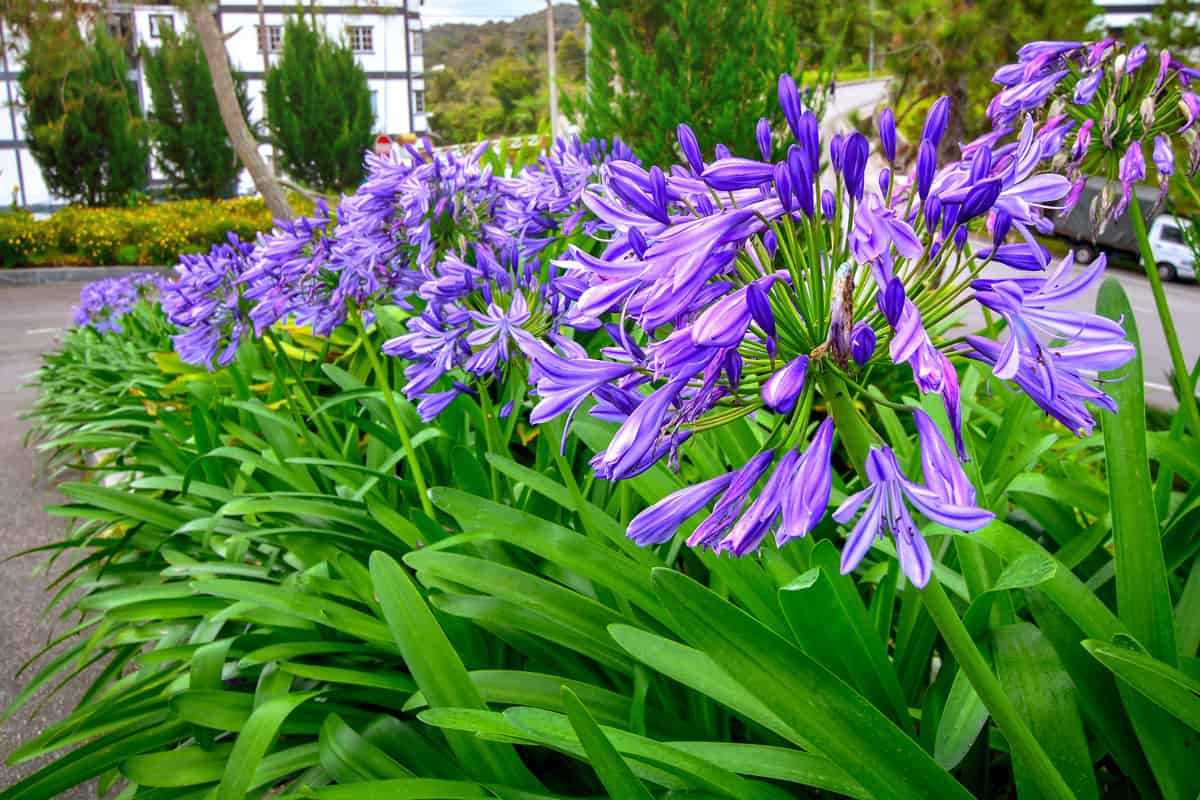Agapanthus is a stunning flowering plant that can add a touch of elegance and beauty to any garden or home. To grow agapanthus successfully, it's essential to understand the best practices for planting it. If you’re looking for answers to these questions, you’ve come to the right place. We've researched this plant and have information to share.
Agapanthus should be planted in a spot with full sun to partial shade and well-draining soil. It can be planted in the ground or in containers in the spring or early summer.
The planting process plays a crucial role in the health and growth of your agapanthus. So, whether you're a seasoned gardener or a beginner, read on to discover everything you need to know to get started with growing this exquisite flowering plant.

How to Plant Agapanthus

To ensure that the plant thrives and produces abundant blooms, it is essential to plant it correctly. Here's a step-by-step guide on how to plant agapanthus:
Prepare the Soil
Agapanthus prefers slightly acidic soil with a pH between 5.5 and 7.0. Add some organic matter, such as compost or well-rotted manure, to the soil to enrich it and improve drainage.
Dig a Hole
Dig a hole twice the size of the root ball, making sure it is deep enough to accommodate the entire root system.
Plant the Agapanthus
Place the plant in the hole and backfill it with soil. Ensure that the top of the root ball is level with the soil surface. Tamp down the soil around the plant to remove air pockets.
Water the Plant
Water the agapanthus thoroughly after planting. Keep the soil moist but not waterlogged.
Add Mulch
Add a layer of organic mulch, such as bark chips or straw, around the plant to help retain moisture and suppress weed growth.
Fertilize the Plant
Fertilize the agapanthus with a balanced fertilizer once or twice a year in the spring and fall. Avoid over-fertilizing as it can cause excessive foliage growth at the expense of flowers.


Check out this fertilizer on Amazon.
Care for the Plant
Agapanthus requires regular watering and maintenance to thrive. Deadhead spent flowers to encourage more blooms and divide the plant every few years to prevent overcrowding.
When to Plant Agapanthus

The ideal time to plant agapanthus depends on a few factors, including the season and the hardiness zone. Here are things to consider when planting agapanthus:
Season
In general, the best time to plant agapanthus is in the spring, after the last frost date in your area. Planting in the spring allows the plant to establish its roots before the hot and dry summer months.
Hardiness Zone
Agapanthus is a tender perennial and can only survive in USDA hardiness zones 8 through 10. If you live in a colder climate, you can grow agapanthus in containers and bring them indoors during the winter.
Where to Plant Agapanthus
Agapanthus is a versatile plant that can be planted in a variety of locations, including:
Garden Beds
Planting agapanthus in a garden bed can add color and texture to your landscape. When planting in garden beds, ensure that the location receives plenty of sunlight, has well-draining soil, and is easily accessible for watering.
Containers
Agapanthus can be grown in containers, making it a great choice for small gardens or patios.
Check out this product on Amazon.
When planting in containers, ensure that the container has drainage holes, use well-draining potting soil, and provide regular watering and fertilization.
Slopes
Agapanthus is an excellent choice for planting on slopes, as it can help prevent erosion and add color to a steep area. When planting on slopes, ensure that the soil is well-draining and use a mulch to help retain moisture.
Borders
Agapanthus is an excellent choice for planting along borders, as it can add color and texture to the edge of a garden or landscape.
When planting along borders, ensure that the location receives plenty of sunlight and has well-draining soil.
Growing Agapanthus from Seed
Growing agapanthus from seed can be a rewarding experience, although it can take some patience and time. Here are the steps to grow agapanthus from seed:
Collect the Seeds
Agapanthus seeds can be collected from mature flower heads that have dried out on the plant. Collect the seeds by shaking the flower heads into a container or bag.
Prepare the Soil
Agapanthus seeds require a well-draining soil mix that is rich in organic matter. Mix equal parts of potting soil, peat moss, and perlite to create a well-draining soil mix.
Sow the Seeds
Fill a seed tray or container with the soil mix and sprinkle the seeds on top of the soil. Gently press the seeds into the soil, but do not cover them with soil as they require light to germinate.
Water the Seeds
Water the soil lightly with a spray bottle or misting nozzle to avoid disturbing the seeds. Keep the soil moist but not waterlogged.
Provide Warmth and Light
Agapanthus seeds require warmth and light to germinate. Place the seed tray in a warm, well-lit location, such as a windowsill or greenhouse. The ideal germination temperature is between 68-75°F.
Wait for Germination
Agapanthus seeds can take several weeks to germinate. Once the seeds have germinated and the seedlings have grown to a few inches tall, transplant them into larger containers or plant them in the garden.
Care for the Seedlings
Agapanthus seedlings require regular watering and fertilization. Keep the soil moist but not waterlogged, and fertilize every 2-3 weeks with a balanced fertilizer.
Is Agapanthus Better In Pots or In The Ground?
Agapanthus can be grown in containers as well as directly in the ground, but they tend to produce better blooms if their roots are restricted, making them an ideal choice for pot culture.
It is recommended to use terracotta pots as they can keep the roots warm in summer. Here are other reasons why it is better to plant in pots:
Control Over Soil Quality
When planting in a pot, you have complete control over the quality and composition of the soil. You can select a well-draining mix that is suited to the needs of the plant.
Easy to Manage
Potted plants are easier to move around, making it easier to position the plant where it can get the right amount of sun or shade, depending on its needs.
Additionally, plants in pots can be moved indoors during the winter months, protecting them from frost and other weather-related damage.
Prevents Overgrowth
Agapanthus is a plant that can spread quickly and aggressively, which can be problematic in garden beds. By planting in a pot, you can prevent the plant from overgrowing and becoming invasive.
When Will My Agapanthus Flower?
Generally, agapanthus plants take about two to three years to reach maturity and begin flowering, although some cultivars may take longer.
It's worth noting that when growing agapanthus from seed, it can take several years for the plant to mature enough to produce flowers.
In contrast, growing agapanthus from bulbs or dividing an established plant will typically result in quicker flowering.
Why Isn't My Agapanthus Flowering?

Your agapanthus may fail to flower for a number of reasons. Here are some of them:
Lack of Sunlight
Agapanthus requires plenty of sunlight to flower. If your plant is not receiving enough sunlight, it may not produce blooms.
Ensure that the location where you planted the agapanthus receives at least six hours of direct sunlight per day.
Overcrowding
Agapanthus can become overcrowded, which can lead to a lack of flowers. Overcrowding can occur if you plant too many agapanthus plants in one location or if you fail to divide the plants regularly.
If your agapanthus is overcrowded, consider dividing the plants and replanting them in a new location.
Improper Watering
Agapanthus requires regular watering, especially during the growing season. However, overwatering or underwatering can both cause problems.
Overwatering can lead to root rot, while underwatering can cause stress on the plant. Ensure that the soil is moist but not waterlogged.
Lack of Nutrients
Agapanthus requires proper nutrients to flower. If the soil is lacking in nutrients, the plant may not produce blooms. Fertilize your agapanthus during the growing season to ensure that it receives the nutrients it needs.
Improper Pruning
Agapanthus should be pruned regularly to promote healthy growth and flowering. However, if you prune your agapanthus at the wrong time or in the wrong way, it may not produce blooms.
You should prune your agapanthus after it has finished blooming and only remove dead or damaged foliage.
The Takeaway
Agapanthus is a beautiful plant that can add color and interest to any garden or landscape. Whether you choose to grow them in pots or in the ground, in sunny or partly shaded areas, agapanthus can thrive with proper care and attention.
With their striking blooms and low-maintenance nature, agapanthus can be an excellent addition to any outdoor space.
Love what you read? You can check out other posts below!
How To Grow Geraniums [Care Tips, Pictures And More]
Exotic Emperor Tulip Plant Guide [Care Tips, Pictures, and More]






